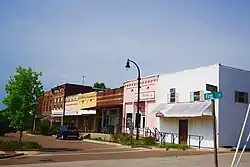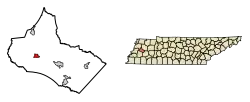Maury City, Tennessee
Maury City is a town in Crockett County, Tennessee. The population was 674 at the 2010 census. Locals pronounce the town's name as "Murray City."
Maury City, Tennessee | |
|---|---|
 Businesses along 1st Street | |
 Location of Maury City in Crockett County, Tennessee. | |
| Coordinates: 35°48′56″N 89°13′26″W | |
| Country | United States |
| State | Tennessee |
| County | Crockett |
| Area | |
| • Total | 1.13 sq mi (2.92 km2) |
| • Land | 1.13 sq mi (2.92 km2) |
| • Water | 0.00 sq mi (0.00 km2) |
| Elevation | 351 ft (107 m) |
| Population (2010) | |
| • Total | 674 |
| • Estimate (2019)[2] | 659 |
| • Density | 585.26/sq mi (225.94/km2) |
| Time zone | UTC-6 (Central (CST)) |
| • Summer (DST) | UTC-5 (CDT) |
| ZIP code | 38050 |
| Area code(s) | 731 |
| FIPS code | 47-46540[3] |
| GNIS feature ID | 1292965[4] |
History
Maury City is named for congressman and state legislator Abram Poindexter Maury (1801–1848). The city incorporated in 1911.[5]
Charles P. Roland, historian of the Civil War and the American South, was born in Maury City in 1918. His father, Clifford Paul Roland, was a schoolteacher in Maury City.[6]
Geography
Maury City is located at 35°48′56″N 89°13′26″W (35.815535, -89.223866).[7] The town is situated at the intersection of State Route 88 and State Route 189, northwest of Jackson and southeast of Dyersburg. SR 88 connects the city with U.S. Route 412 and Alamo to the east, and with the Halls area to the west. SR 189 connects Maury City with Friendship to the north.
According to the United States Census Bureau, the town has a total area of 1.1 square miles (2.8 km2), all land.
Demographics
| Historical population | |||
|---|---|---|---|
| Census | Pop. | %± | |
| 1920 | 452 | — | |
| 1930 | 425 | −6.0% | |
| 1940 | 412 | −3.1% | |
| 1950 | 553 | 34.2% | |
| 1960 | 624 | 12.8% | |
| 1970 | 813 | 30.3% | |
| 1980 | 989 | 21.6% | |
| 1990 | 782 | −20.9% | |
| 2000 | 704 | −10.0% | |
| 2010 | 674 | −4.3% | |
| 2019 (est.) | 659 | [2] | −2.2% |
| Sources:[8][9] | |||
As of the census[3] of 2000, there were 704 people, 301 households, and 195 families residing in the town. The population density was 632.0 people per square mile (244.9/km2). There were 325 housing units at an average density of 291.8 per square mile (113.0/km2). The racial makeup of the town was 62.64% White, 32.81% African American, 0.14% Asian, 2.98% from other races, and 1.42% from two or more races. Hispanic or Latino of any race were 4.12% of the population.
There were 301 households, out of which 27.6% had children under the age of 18 living with them, 48.5% were married couples living together, 13.6% had a female householder with no husband present, and 34.9% were non-families. 31.9% of all households were made up of individuals, and 14.6% had someone living alone who was 65 years of age or older. The average household size was 2.34 and the average family size was 2.92.
In the town, the population was spread out, with 22.6% under the age of 18, 8.9% from 18 to 24, 26.8% from 25 to 44, 25.0% from 45 to 64, and 16.6% who were 65 years of age or older. The median age was 39 years. For every 100 females, there were 89.2 males. For every 100 females age 18 and over, there were 86.0 males.
The median income for a household in the town was $26,645, and the median income for a family was $33,250. Males had a median income of $23,250 versus $24,375 for females. The per capita income for the town was $14,519. About 13.7% of families and 16.1% of the population were below the poverty line, including 17.8% of those under age 18 and 16.4% of those age 65 or over.
References
- "2019 U.S. Gazetteer Files". United States Census Bureau. Retrieved July 30, 2020.
- "Population and Housing Unit Estimates". United States Census Bureau. May 24, 2020. Retrieved May 27, 2020.
- "U.S. Census website". United States Census Bureau. Retrieved 2008-01-31.
- "US Board on Geographic Names". United States Geological Survey. 2007-10-25. Retrieved 2008-01-31.
- Larry Miller, Tennessee Place Names (Indiana University Press, 2001), p. 133.
- Who's Who in America, 1982-1983 (Chicago, Illinois: Marquis Who's Who, 1982), p. 2844
- "US Gazetteer files: 2010, 2000, and 1990". United States Census Bureau. 2011-02-12. Retrieved 2011-04-23.
- "Census of Population and Housing: Decennial Censuses". United States Census Bureau. Retrieved 2012-03-04.
- "Incorporated Places and Minor Civil Divisions Datasets: Subcounty Resident Population Estimates: April 1, 2010 to July 1, 2012". Population Estimates. U.S. Census Bureau. Archived from the original on 11 June 2013. Retrieved 11 December 2013.
External links
 Media related to Maury City, Tennessee at Wikimedia Commons
Media related to Maury City, Tennessee at Wikimedia Commons